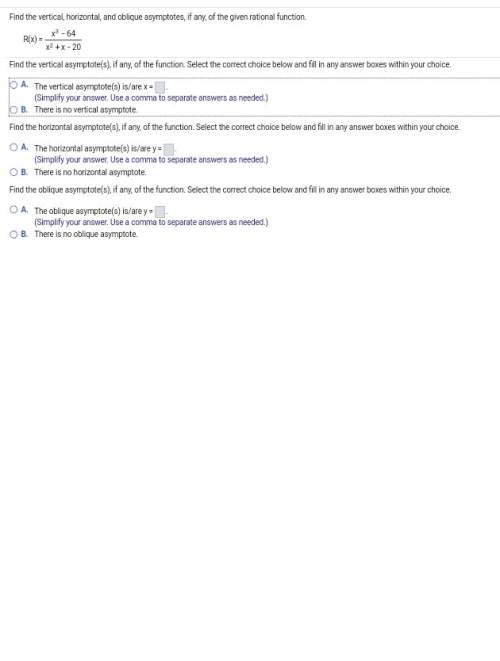Find the vertical, horizontal, and oblique asymptotes, if any, of the given rational function.
...

Mathematics, 19.10.2019 12:20 Homepage10
Find the vertical, horizontal, and oblique asymptotes, if any, of the given rational function.
r(x)= x^3-64÷x^2+x+20
a.
the vertical asymptote(s) is/are x equals=
(simplify your answer. use a comma to separate answers as needed.)
b.
there is no vertical asymptote.
find the horizontal asymptote(s), if any, of the function. select the correct choice below and fill in any answer boxes within your choice.
a.
the horizontal asymptote(s) is/are y equals=
(simplify your answer. use a comma to separate answers as needed.)
b.
there is no horizontal asymptote.
find the oblique asymptote(s), if any, of the function. select the correct choice below and fill in any answer boxes within your choice.
a.
the oblique asymptote(s) is/are y equals=
nothing.
(simplify your answer. use a comma to separate answers as needed.)
b.
there is no oblique asymptote.
click to select and enter your answer(s).


Answers: 1
Another question on Mathematics

Mathematics, 21.06.2019 16:50
The verbal translation for the difference of m and 7 increased by 15
Answers: 3

Mathematics, 21.06.2019 18:20
What is the solution to the equation? k/6.4=8.7 2.3 5.568 15.1 55.68
Answers: 1

Mathematics, 21.06.2019 19:30
1. find the area of the unshaded square 2. find the area of the large square 3. what is the area of the frame represented by the shaded region show
Answers: 1

Mathematics, 21.06.2019 19:50
Asequence is defined recursively using the formula f(n + 1) =f(n) - 5. which sequence could be
Answers: 1
You know the right answer?
Questions




Mathematics, 21.01.2021 19:20


Computers and Technology, 21.01.2021 19:20

Mathematics, 21.01.2021 19:20

Mathematics, 21.01.2021 19:20

Mathematics, 21.01.2021 19:20




Biology, 21.01.2021 19:20

Mathematics, 21.01.2021 19:20


History, 21.01.2021 19:20

Mathematics, 21.01.2021 19:20

Biology, 21.01.2021 19:20




